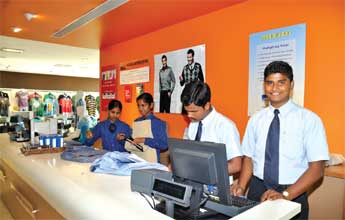Enabling the young to garner demographic dividend
Today, more than half of India’s population is below the age of 25. In another seven years, India’s average age will be just 29 years, in comparison with 37 in China and the United States, 45 in Western Europe and 48 in Japan; making it the country with the largest young population in the world.
The period between the age of 15 and 29 marks a transition phase in life – the culmination of education, economic independence, acquisition of professional and technical skills, new living arrangements and increasing acceptance of domestic responsibilities. Youth is an age ripe with promises, expectations and aspirations about the future.
But unfortunately today this age group is also increasingly marked by economic and social vulnerability for many young people. According to the International Labour Organisation (ILO) estimates, although youth comprise around 25% of the world’s working-age population, they constitute around 44% of the unemployed.
One would think that the case in India, the nation soon to be with the largest young population, might be different. But the statistics for India are just as alarming. The 68th Round Survey Report by the National Sample Survey Organization (NSSO) reveals that the unemployment rate (the unemployed per 1000 citizens in the workforce) has increased from 25 to 27 in the last two years. In figures this translates to 10.8 million unemployed young men and women.
The unemployment rate in India has been largely influenced by the shift of economy from the agricultural to the service sector. The closing years of the last century brought about the phenomenal rise of the ‘new middle class’ in post-liberalisation India. This class raised without shortages and rationing, redefined the mores and manners of a generation, especially their newfound consumer identities, leading to an upsurge in the service and retail industry.
This development brought with it an unprecedented need for nation-wide availability of skilled labour and an increased demand for comprehensive skills training. Youth, eager to participate in the globalized economy, began moving in droves to centres of finance, industry and opportunity – the cities. And then the crisis revealed itself. NSSO reports show that while the growing industry and service sector created jobs, the gap between the demands of employers and the training of the workforce led in fact to increasing unemployment.
If, as the numbers show, an undergraduate degree holder is likelier to be employed today than in 2004-05, but continues to be less likely to be
employed than someone who is illiterate, it points to a yawning gap in the employability of many educated Indians.
This gap seems to have grown in recent years due to fast changes in production technologies and structures, to which the educational institutions and skill supply mechanisms have not been quick enough to respond. Skills and knowledge are the driving forces of economic growth and social development for any country.
As India moves progressively towards becoming a ‘knowledge economy’ it becomes increasingly important that the country should focus on advancement of skills and these skills have to be relevant to the emerging economic environment. But facts show that there is a clear dearth of institutions providing professional skills training to youth, which should also be affordable.
A situation and needs assessment survey for youth, conducted by the Population Council of India in six states, brings out the dismal facts – over half of the young men and two-thirds of the young women surveyed, reported interest in skills training. However, far fewer, just 21% of young men and 25% of young women, had attended any training programme.
Shreyas Dhepe, a 22 year old from Dharavi, Mumbai, belonged to the former group. His father, working as a guard at a small hotel and the sole earning member in the family of six, had high hopes from Shreyas when he graduated with a B.Com degree. But every job interview he went to, turned out to be a disappointment. The family’s aspirations slowly started ebbing, as disillusionment settled in. In all his years of education, Shreyas had never received even basic computer education and his communication skills were also poor. All he could get were very low paying informal jobs, which could not even fulfil his own needs, let alone the family’s.
The window of opportunity opened for Shreyas when he enrolled in Smile Foundation’s Smile Twin e-Learning Programme (STeP) at the Jan Sewak Sangha in Mumbai. STeP is a national level livelihood programme that trains urban underprivileged youth with market-oriented job skills such as English, basic computer, personality development, retail management and other relevant soft skills and facilitates their employment in retail and service sectors across India.
After completion of the six month programme, Shreyas was offered a position with the Apollo Pharmacy. Today he earns a decent income and helps out his father with household expenses. His two younger sisters look up to him. Like Shreyas, more than 13,750 youth have been trained and 9850 have been placed in over 140 brands through 35 operational projects under STeP across India.
But, to fulfil the country’s target of skilling 500 million youth till 2022, there’s still a long way to go. The country must significantly strengthen investments in programmes that enable youth to make a successful transition to work roles. Enhancing employability would depend to a considerable extent on the improvements in educational attainment; but it would require a much greater investment in enabling youth to acquire employability skills.
Youth development must be brought at the centre of all socio-political dialogue and legislative policies. The United Nations Organization has also identified unemployment rate among youth as one of the key indicators for monitoring the progress towards achieving the Millennium Development Goals.





